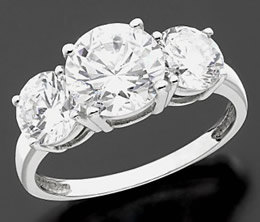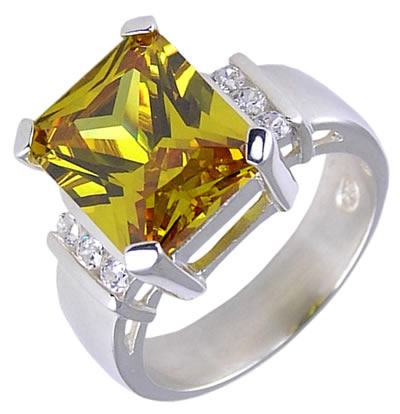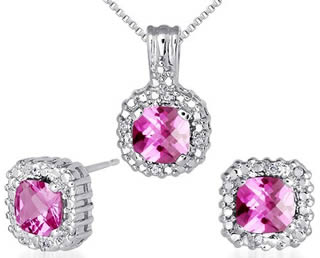Your Details
Your Details
|
Reviewed By Andreas Zabczyk
Cubic Zirconia Gemstones
White Cubic Zirconia Ring
While diamonds are not actually rare - about 100 million carats of gem-quality diamonds were produced in 2008 - they are certainly expensive. So there have been many attempts to market diamond simulants; gems that have similar gemological characteristics to diamond but that could be offered on the market at a much lower price. A diamond simulant is not a synthetic diamond since synthetic diamonds are real diamonds (though produced in a laboratory rather than by nature). A simulant is a natural or synthetic material that can imitate or be a lower cost substitute for diamond. A successful diamond simulant needs to be hard (diamond has a hardness of 10 on the Mohs scale), display excellent brilliance and fire, and have a color (or lack of color) similar to diamond. Many materials have been tried, from manufactured leaded glass (rhinestone) to natural gemstones such as white sapphire, spinel and zircon. 
Yellow Cubic Zirconia Ring
From around 1946, a succession of synthetic materials were offered on the market as diamond simulants. They included synthetic rutile (titanium oxide), strontium titanite and YAG (yttrium aluminum garnet). All of these proved less than ideal; rutile had too much fire and looked obviously fake, while strontium titanite was much too soft (only 5.5 on the Mohs scale). YAG was a distinct improvement, but by the late 1970s it was eclipsed by the first truly successful diamond simulant, cubic zirconia. Also known by the acronym CZ, cubic zirconia is zirconium dioxide that is synthesized in a laboratory. The "cubic" part of the name indicates that the zirconia has been produced to form in cubic crystals, like diamond. This is not typical for zirconia - its stable form is monoclinic crystals, like spodumene or sphene. A special stabilizer must be used to grown zirconia in cubic crystals. Cubic zirconia has a hardness of 8 to 8.5 and a refractive index (2.15 to 2.18) and dispersion (0.058 to 0.066) that is quite similar to diamond. In fact CZ's appearance is close enough to diamond to fool most people who do not handle diamond regularly. In addition, CZ's low cost is a major attraction and has been vital to its considerable market success. 
Pink Cubic Zirconia Jewelry
CZ is quite easy for gemologists and even jewelers to detect. The simplest test is to use a diamond tester with a thermal probe. Diamond is an excellent thermal conductor, which is why diamond feels cold when you touch it to your lip. CZ, like most diamond simulants, is a thermal insulator. There are quite a few other differences between cubic zirconia and diamond. CZ is usually internally flawless and completely colorless, whereas most diamonds have some internal imperfections and a yellow tint. CZ is also manufactured in a number of different colors meant to imitate fancy diamonds (such as yellow, orange, pink, green and black), but most of these do not approximate the genuine article. CZ is softer than diamond and will acquire scratches over time. Testing the density of a sample is also a giveaway - CZ has a a very high specific gravity of 5.6 to 6 while diamond's is 3.5 to 3.53. Therefore a one-carat CZ will be much smaller than a one-carat diamond. |
